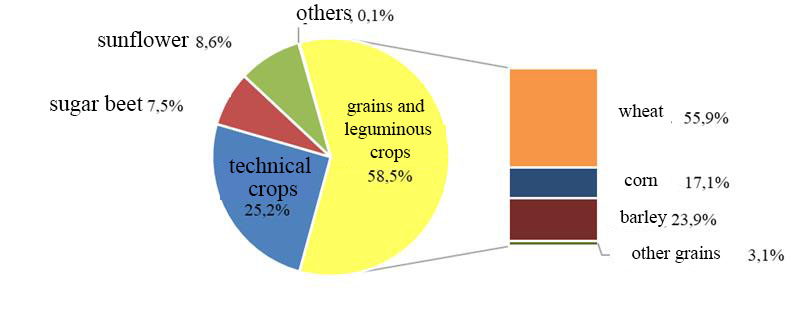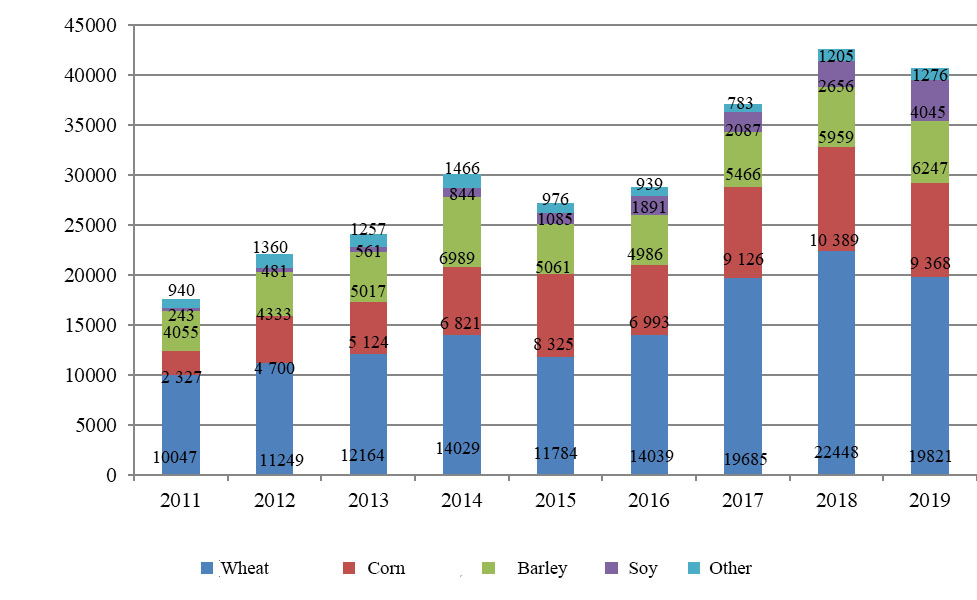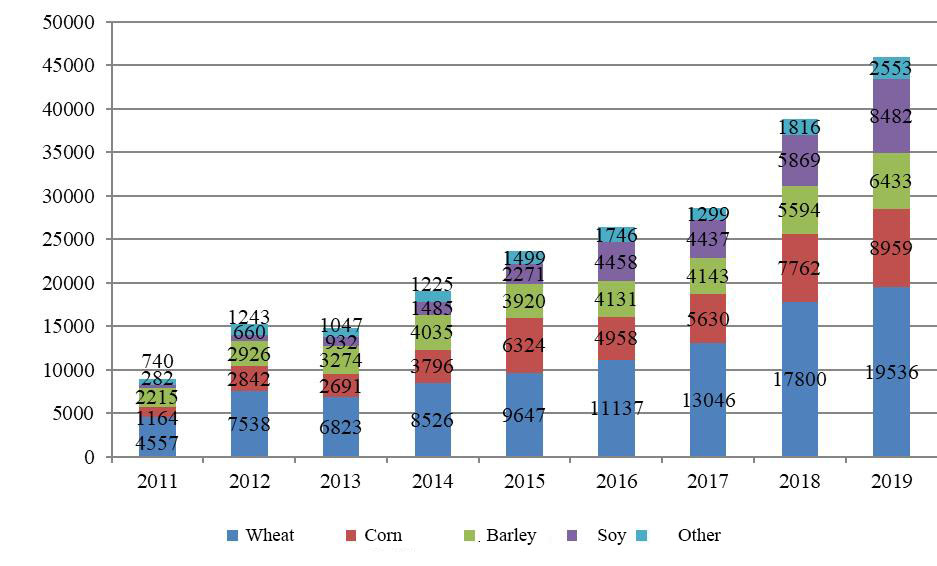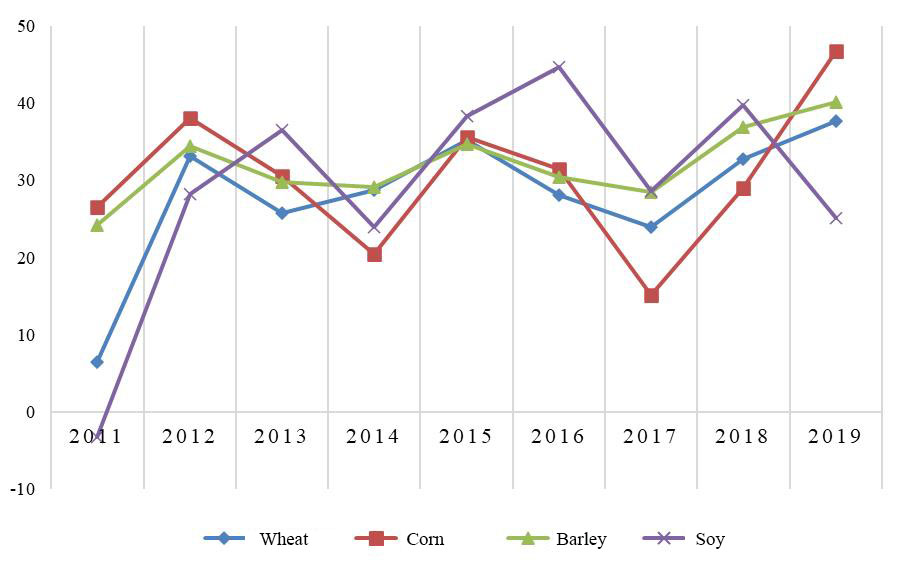Abstract
The article analyzes the production and sale of grain in agricultural enterprises of the Kursk region. Changes in the size and structure of crops are revealed, the dynamics of production and sales of the main types of grain crops for 2011-2019 are analyzed both in physical weight and in value terms. It was found that during the study period, the dynamics of production and sale of grain crops in the Kursk region have a generally positive trend. The valuation of the dynamics of sales of products of the main types of grain crops demonstrates steady growth due to the rise in prices for products. The article presents trend models that allow assessing the dynamics and forecasting the development of grain production and sales in the Kursk region. It was revealed that among all grain crops the maximum growth in sales volumes is steadily demonstrated by wheat. The function obtained from the results of trend modeling with a high degree of reliability indicates the actual growth and allows us to predict an increase in sales of wheat for the region. It is concluded that the factors that influenced the changes and identified the prospects for growth in the production of certain types of crops.
Keywords: Agriculture, grain, Kursk region, production, profitability
Introduction
Grain production is one of the strengths of agriculture in the Kursk region. This is ensured by significant areas of black earth lands and favorable weather conditions. Region is one of the leaders in Russia in grain production, and in terms of grain yield, the Kursk region takes 1st place in the Central Federal District. Production growth rates exceed the national average. On the one hand, demand is supported by the largest megacities - Moscow and St. Petersburg with adjacent regions, on the other - by livestock farms in the Central Black Earth Region, primarily in the Belgorod and Kursk regions (Zaretskaya, 2019). The location of Kursk region makes it possible to export grain (Zyukin et al., 2020) to the harbors of southern and northwestern Russia.
Problem Statement
Despite the dynamic development and growth of grain production in Russia as a whole and in the Kursk region, in particular, the development of the agricultural industry is accompanied by several unsolved problems that require additional research. An increase in grain production over the needs of the region and the country sets the producers and the state (Latysheva et al., 2020) tasks in the form of developing export infrastructure, changing the structure of production following the needs of the world, not the domestic market, and the need to consider world grain prices. These factors increase the relevance of both the study of current trends in the field of grain production and the current situation, as well as forecasting market processes for the coming years.
Research Questions
Study of the structure and dynamics of grain production, assessment and description of the factors that determine these changes.
Modeling the volume of grain production in the Kursk region.
Interpretation of the obtained models and substantiation of the prospects for their use in the activities of agricultural organizations and public authorities
Purpose of the Study
The aim of the work is the mathematical modeling of the processes occurring in the grain market, assessment of factors that influenced the change, and forecasting trends for the coming years, which will justify promising management decisions for agricultural organizations and government bodies.
Research Methods
The study was carried out based on the data of the committee of the agro-industrial complex of the Kursk region on agricultural organizations. In the process of analysis we studied the dynamics of the structure of production and sales of major types of crops for 2011-2019.
Findings
The strategic direction of development for the region (Vodolazskaya, 2013) is currently the stabilization of grain production, and the task of the near future is to increase the gross harvest of grain crops (Petrushina, 2021). In the structure of the sown areas of the Kursk region in 2019, the largest share (58.5%) was occupied by grain crops - Figure 1.

Winter and spring wheat accounted for 55.9% of the total sowing of cereals in the region, barley - 23.9%, corn for grain - 17.1%, other grains - 3.1%. This structure reflects the region's grain specialization in growing wheat and barley (Pronskaya et al., 2020).
During the study period, the dynamics of the sale of grain crops in the Kursk region has mainly a positive trend in both physical and value terms - Figure 2.

Wheat sales indicators in 2019 in comparison with 2011 increased by almost 2 times. This is since wheat is one of the main crops in the grain group of the crop rotation. At the same time, in 2019, there is a decrease in production compared to 2018 by almost 10%. The high level of precipitation in the Kursk region led to the partial death and unsuitability of the crop for further processing. Excessive moisture with a lack of use of plant protection products led to the development of fungal diseases, therefore, part of the grain became unsuitable for the food industry, which worsened production and financial indicators.
The production of corn for grain increased significantly - the main factors were the development of animal husbandry (since it is the main fodder crop in various types of feed), as well as an increase in starch production. Maize produces higher, sustainable yields compared to other forage crops and fit positively into the crop rotation as a good predecessor. In 2019, 9368 thousand centners of corn were sold, which is 7,041 thousand centners (4 times) higher than the 2011 level. But in 2019, its production decreased relative to 2018, by analogy with wheat - by 1,021 thousand centners.
Barley production also increased significantly during the analyzed period. In 2019, 6,247 thousand tonnes of barley were sold, which is 1.5 times higher than the level of 2011. Barley is grown both for fodder purposes (livestock feed) and for the brewing industry. In the ranking of regions by the size of barley areas in 2019, the Kursk region takes the 13th position (256.9 thousand hectares, 2.9% of the total sown area). In the rating of regions in terms of the gross barley harvest in 2019, the Kursk region was in second place (harvests amounted to 1,087.1 thousand tons, and the share in the total harvest was 5.3%), overtaking the Krasnodar Territory.
Soy is a legume that is also in demand both in the food market and in animal husbandry, providing stable yields and grown mainly in the central regions. Currently, the demand for soybeans as the most affordable source of vegetable protein is steadily increasing, and in recent years this crop has shown strong economic indicators.
The cost estimate of the production and sale of the main types of grain crops is shown in Figure 3.

The valuation of the dynamics of sales of products of the main types of grain crops demonstrates a steady growth due to the increase in prices for products, and a decrease in this indicator is noted only in 2013 (and in 2015, 2016, and 2019, with a decrease in the physical volumes of sales, the cost increased). Figure 4 shows the dynamics of the profitability of sales of the main types of grain crops (Petrushina, 2020).

Profitability indicators demonstrate a unidirectional dynamic of change, simultaneously increasing and decreasing during the analyzed period. This indicates that the financial performance of these types of products is influenced by the same market factors (Purwanto et al., 2019).
This situation is caused by the following reasons:
1. Various types of grain crops are substitute goods, and when the supply of some types of grain changes, demand switches to others, balancing the market and leveling profitability for various types of products.
2. Production factors and cost are more stable over time (Zaretskaya & Chernikova, 2020), and differences in production technologies and changes in costs for certain types of grain crops are less significant compared to market factors that, as noted above, affect the market.
3. As Russia enters world markets and increases its exports, world prices also have a greater impact on demand, which determines the unidirectional dynamics of prices.
The high growth rates of grain production in the presence of comparative competitive advantages in the world market made it possible to increase the volume of its exports. Kursk grain is supplied to more than 20 countries of the world. Its main consumers are Latvia, Lithuania, Egypt, Turkey, Kazakhstan (Zaretskaya, 2018). The region has all the prerequisites for expanding the geography of sales markets, and the possibility of increasing exports.
Table 1 shows trend models, which make it possible to assess the dynamics and predict the development of grain production and sales in the Kursk region.
The table presents models by grain types, which are described with sufficient reliability. Trend models were also calculated for other types of grain during the study, but the modeling results have a low degree of reliability and can not act as a basis for predicting the implementation of future periods.
Conclusion
Among all grain crops, the highest growth in sales volumes is consistently demonstrated by wheat. The function obtained from the results of trend modeling with a high degree of reliability indicates the actual growth and makes it possible to predict an increase in the sales of wheat for the region by 1.462 million centners. in year. The steadily growing demand for wheat in the domestic national and world markets contributes to an active increase in production and sales volumes. Considering that wheat is the main exported type of grain both in the Kursk region and in the whole of the Russian Federation, the export duties implemented in the 2020-2021 season, combined with a potential decrease in yield due to unfavorable weather conditions during the sowing season, can make a significant adjustment to the forecast results (Voronina & Zaretskaya, 2019). The shift in consumer preferences of the population towards essential products from wheat grain caused by the pandemic of the new coronavirus infection and a stable increase in the livestock population may have some positive impact and support the demand for wheat in the domestic market, which, together with the government's restrictive measures on exports (Fomin & Boev, 2008), may have a stimulating effect on prices.
The market instability inherent in the corn market in the last decade, together with a relatively high price elasticity of demand and significant dependence of crops on climatic conditions, deter agricultural producers from increasing the production of this type of grain. The trends of the previous periods reflect the annual growth of sales of corn in the amount of 890 thousand tons and allow predicting this growth with a high degree of certainty for the coming years (Zyukin et al., 2020). However, the expected transformation of acreage because of export duties on wheat, a high regional concentration of corn production, stable growth in demand from feed producers, a decrease in seed grain imports, and the attractiveness of corn for deep processing allow us to expect a more active increase in the production and sale of corn in the Kursk region.
The dynamics of changes in sales volumes of barley is poorly predictable because the resulting trend model has a coefficient of approximation reliability of 0.379, while the model of proceeds from the sale of this type of product shows a stable growing trend and with a reliability of 0.893 allows us to expect an increase of 445 million rubles annually. These trends occur due to the growing demand for this type of grain, formed by the needs of domestic consumption from the livestock industry, and an increase in export attractiveness - in 2020 alone, the volume of Russian barley exports increased by 1/3 of the whole volume.
The results of trend modeling of the dynamics of production and sales of soybeans demonstrate an increase in sales volumes of this type of grain by an average of 431 thousand centners. annually. Favorable conditions for the growth of production and sales of soybeans are created by the growing global and national demand for soybean meal due to the increase in feed production and the rapid development of the bioindustry. Soybeans are the most attractive and cost-effective raw material. In the short term, in addition to market factors, government support will also contribute to the growth of soybean production, since in 2020 a regional subsidy has been introduced to stimulate an increase in the production of soybeans and rapeseed (Fomin & Ogu-Oluva, 2020). According to the simulation results, the average annual increase in the number of proceeds received from the sale of soybeans is 974 million rubles, due to both the influence of sales volumes and the price factor. Because soybeans are a direct competitor to corn in feed production, rising prices in the corn market and the vegetable oil market will also put pressure on the price of soybeans.
Based on the results of the study, it can be concluded that significant growth rates of production and sale of grain necessitate changes in the guidelines of state regulation of the development of the agricultural sector. If during the period of production decline the main priority was focused on the growth of production to ensure food security, then in the current situation it is necessary to reorient towards the development of export potential and the corresponding infrastructure (Solovieva & Zhilyakov, 2009). In this situation, some methods that have been effective in the past do not prove to be effective or even form negative consequences for the industry.
For agricultural organizations, it becomes obvious that it is necessary to consider the dynamics of production and sales of grain production soon to predict the future structure of sales and ensure the sale of manufactured products.
In this situation, it is also becoming clear that production should be oriented towards grain export and the development of the country's export potential. Overcoming the deep crisis in agriculture in the 1990s, as well as the growth model of the early 2000s, which was based on an increase in domestic consumer demand for food, has exhausted itself. At present, to continue the growth and development of both the agricultural sector as a whole and grain production, it is necessary to carry out a transition from import substitution to an export-oriented development strategy to reduce the excessive pressure on the market supply of grain within the country.
References
Fomin, O. S., & Boev, S. G. (2008). Directions of state regulation of investment activities in the agricultural sector. Achievements of science and technology of the agro-industrial complex, 1, 8-9.
Fomin, O. S., & Ogu-Oluva, A. A. (2020). Problems of state regulation of agricultural production. Innovations in the scientific and technical support of the agro-industrial complex of Russia. In Materials of the All-Russian (national) scientific and practical conference (pp. 34-37). Kursk State Agricultural Academy.
Latysheva, Z. I., Skripkina, E. V., Kopteva, N. A., Zhilyakov, D. I., & Nikiforov, A. I. (2020). Improving the state regulatory system of the agribusiness. Cuestiones Políticas, 65, 116-126.
Petrushina, O. V. (2020). Improving e-commerce in grain in the context of the digital transformation of the agro-industrial complex. In Modern economy: topical problems, tasks and development trajectories: Materials of the All-Russian (national) scientific-practical conference (pp. 204-209). Kursk State Agricultural Academy.
Petrushina, O. V. (2021). Export-oriented strategy of grain production. Bulletin of the Kursk State Agricultural Academy, 2, 90-97.
Pronskaya, O. N., Fomin, O. S., & Zhilyakov, D. I. (2020). Prospects for the development of personal subsidiary plots and other small forms of farming in the countryside. Bulletin of the Kursk State Agricultural Academy, 5, 230-239.
Purwanto, R. M., Mukharrom, T., Zhilyakov, D. I., Pamuji, E., & Shankar, K. (2019). Study the importance of business ethics and ethical marketing in digital era. Journal of Critical Reviews, 5, 150-154.
Solovieva, T. N., & Zhilyakov, D. I. (2009). Strategic analysis of the state of the poultry industry in the egg direction. Agro-industrial complex: economics and management, 5, 62-68.
Vodolazskaya, N. V. (2013). Problems and prospects for improving regional marketing strategies. Eastern European Journal of Advanced Technologies, 10(61), 95-98.
Voronina, N. V., & Zaretskaya, V. G. (2019). Problems justifying the discount rate in emerging capital markets. IOP Conference Series: Materials Science and Engineering, 698, 077033.
Zaretskaya, V. G. (2018). Economic diversification in the post-Soviet states. In Innovation Management and Education Excellence through Vision 2020: Proceedings of the 31st International Business Information Management Association Conference (IBIMA) (pp. 2667-2672). International Business Information Management Association.
Zaretskaya, V. G. (2019). Diversification or specialization: development of the regions of the far eastern federal district. Smart Innovation, Systems and Technologies, 139, 280-288.
Zaretskaya, V. G., & Chernikova, E.A. (2020). Gross Regional Product Growth: Factor Decomposition. Bulletin of the South-West State University. Series: Economics. Sociology. Management, 5, 89-103.
Zyukin, D., Zhilyakov, D., Bolokhontseva, Y., & Petrushina, O. (2020). Export of Russian grain: prospects and the role of the state in its development. Amazonia Investiga, 9(28), 320-329.
Zyukin, D. A., Pronskaya, O. N., Golovin, A. A., & Belova, T. V. (2020). Prospects for increasing exports of Russian wheat to the world market. Amazonia Investiga, 28, 346-355.
Copyright information

This work is licensed under a Creative Commons Attribution-NonCommercial-NoDerivatives 4.0 International License.
About this article
Publication Date
01 February 2022
Article Doi
eBook ISBN
978-1-80296-123-2
Publisher
European Publisher
Volume
124
Print ISBN (optional)
-
Edition Number
1st Edition
Pages
1-886
Subjects
Land economy, land planning, rural development, resource management, real estates, agricultural policies
Cite this article as:
Zhilyakov, D. I., Plakhutina, Y. V., Petrushina, O. V., & Skripkina, E. V. (2022). Modeling Of Production And Sale Of Grain At The Regional Level. In D. S. Nardin, O. V. Stepanova, & E. V. Demchuk (Eds.), Land Economy and Rural Studies Essentials, vol 124. European Proceedings of Social and Behavioural Sciences (pp. 141-148). European Publisher. https://doi.org/10.15405/epsbs.2022.02.18

